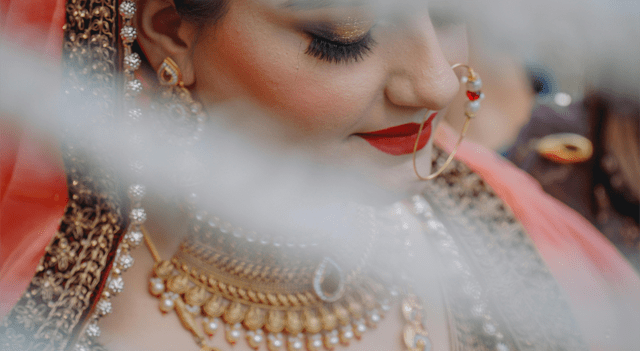For Farzana Ghani, every piece of gold she owns is more than decoration — it’s a personal archive. In a CNN article, she describes the elaborate wedding jewelry gifted by her mother-in-law in Pakistan, a gold chain given by her mother after she completed the Hajj pilgrimage, and gold coins purchased to mark the birth of her daughter.
As prices for the precious metal continue to set new records, Ghani sees no reason to change course.
“Compared to bonds and compared to holding cash, I would still prefer to buy gold coins,” Ghani, 56, of Miami, Florida, said.
In South Asia, gold isn’t just an asset — it’s a legacy. Brides are traditionally adorned from head to toe with gold necklaces, earrings, nose rings, headpieces, and charms, many of which have been inherited over generations. The practice of collecting gold starts early, with families gifting pieces to celebrate births, milestones, and festivals.
While gold has long been recognized as a safe haven investment, its role in South Asia is far more personal. The custom of mothers passing gold to their daughters transcends geography and class, linking urban professionals and rural families alike. Gold is often woven into family traditions, whether through embroidered saris with gold threads or ornate heirloom pieces kept for decades. For many women, this is one of the few financial resources that belong solely to them.
This week, gold hit an all-time high of $4,000 per troy ounce — a 54% jump since the start of the year. The surge has been fueled by US President Donald Trump’s trade policies and growing expectations of interest rate cuts from the Federal Reserve. And for South Asian women who have always relied on gold to store wealth, it’s a moment of financial vindication.
“Whatever I have, it’s all gold,” a South Asian mother declared on TikTok, holding up a 24-carat necklace she purchased 28 years ago. “When I bought this (necklace) right, those days, golds were very cheap. One gram was $12. Now it’s $100.”
According to the World Gold Council, India was the world’s second-largest market for gold jewelry in 2023, after China. In 2021, the country bought 611 tonnes of jewelry — more than double the amount purchased in the Middle East. Weddings are a key driver of this demand. With between 11 and 13 million weddings each year, bridal jewelry accounts for more than half of India’s gold market.
This trend isn’t limited to the subcontinent. South Asian diaspora communities are also buying. Solomon Global, a major UK gold supplier, reports that roughly 10% of its clients are of South Asian heritage, with purchases rising steadily over the past year.
“Jewelry is something that has an auspicious place in people’s lives, it can be very consumer oriented, but it is also a very good mechanism for saving and passing wealth from generation to generation,” said Joseph Cavatoni, senior market strategist for the Americas at the World Gold Council.
In India, explained Sachin Jain, the organization’s India CEO, gold is not seen as a frivolous purchase. It’s a family asset — something that appreciates in value and can be passed down. For women who lack access to formal financial systems, it’s often a crucial lifeline. Less than half of Indian women manage their own finances, according to a YouGov survey conducted in March.
This mindset shaped Ghani’s upbringing. Growing up in Pakistan, her mother encouraged her to save spare cash and buy 24-karat coins as soon as she could.
“We Eastern women are always known for having money on rainy days. We don’t live for today and then forget about tomorrow,” Ghani said.
A Global Shift Toward Gold
In 2025, it’s not just South Asian households flocking to gold. Uncertainty around Trump’s trade war has pushed global investors to move away from volatile currencies and into tangible assets. Gold posted its strongest quarterly gains since 1986, with demand spilling over to silver and platinum.
“Gold is a bastion of safety and value,” said Joshua Barone, a wealth manager at Savvy Advisors. Over the past five decades, gold prices have skyrocketed more than 2,700%, according to BullionByPost, the UK’s largest online gold dealer.
Central banks are also stockpiling the metal. The Reserve Bank of India has increased its holdings by 35% in five years, while China has likewise expanded its reserves.
For many South Asian families, however, gold never left their hands. Jain estimates Indian households store at least 25,000 tonnes of gold privately. And even as prices surge, few are rushing to sell.
“The Western markets tend to want to hold gold when things are really scary, market risk and uncertainty. But (South Asian) families, these generations, have held gold for a long time, because they see that gold grows with economic expansion and it links to the GDP,” Cavatoni said.
Rather than cashing out, more consumers are choosing to modernize their heirlooms. Jewelers have reported an uptick in people melting down old pieces and redesigning them into everyday wear.
“I think the younger consumer wants to own, fall in love and use those pieces, make them part of their life,” Jain said.
When Ghani’s daughter married last December in Miami, Ghani converted her old jewelry and gold coins into sleek, modern pieces that her daughter can wear — and one day pass down. She also reserved coins for her son.
“She wanted to wear artificial (jewelry),” Ghani sighed. “But gold is the most decent, the most elegant. I told her, ‘Do not wear anything else.’”
This content is for informational purposes only and does not constitute financial, investment, or other professional advice. It should not be considered a recommendation to buy or sell any securities or financial instruments. All investments involve risk, including the potential loss of principal. Past performance is not indicative of future results. You should conduct your own research and consult with a qualified financial advisor before making any investment decisions.
